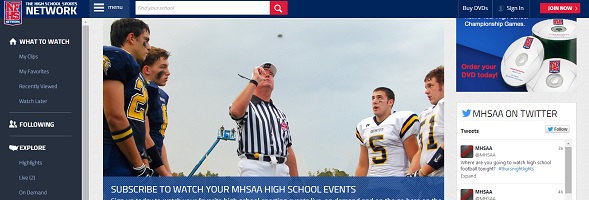
Top-Ranked Clash on MHSAA.tv
January 21, 2015
By John Johnson
MHSAA communications director
A trio of contests highlight the live events being produced by MHSAA members participating in the School Broadcast Program this week on the MHSAA.tv website.
Bloomfield Hills Cranbrook-Kingswood, the top-ranked team in the Division 3 ice hockey coaches association poll this week, has back-to-back contests with top-10 teams this weekend. On Friday (Jan. 23), the Cranes host the third-ranked team in Division 1, Detroit U-D Jesuit, in a key Michigan Interscholastic Hockey League game at 7:15 p.m.; and then on Saturday, face sixth-ranked Plymouth, with the game time to be announced.
On Tuesday (Jan. 19), Goodrich and Haslett squared off in girls basketball. Haslett is ranked fourth in this week’s Associated Press Class B poll, and Goodrich is seventh.
The School Broadcast Program gives members an opportunity to showcase excellence in their schools by creating video programming of athletic and non-athletic events with students gaining skills in announcing, camera operation, directing/producing and graphics. The program also gives schools the opportunity to raise money through advertising and viewing subscriptions.
Here’s the schedule of School Broadcast Program members planning to cover varsity competition over the next week for broadcast at MHSAA.tv (As of Jan. 19). The following events will have live streaming video unless otherwise indicated:
Wednesday, January 21
Wrestling – Lake City & Pine River at Mancelona, 6 p.m.
Girls Basketball – Hemlock at Montrose, 7 p.m.
Thursday, January 22
Boys Swimming & Diving – Holt at Haslett, 6 p.m.
Boys Basketball – Hancock at Calumet, 7 p.m.
Ice Hockey – Escanaba at Calumet, 7 p.m.
Friday, January 23
Girls Basketball – Rogers City at Hillman, 7 p.m.
Girls Basketball – Johannesburg-Lewiston at Mancelona, 7 p.m.
Ice Hockey – Detroit U-D Jesuit at Bloomfield Hills Cranbrook-Kingswood, 7:15 p.m.
Boys Basketball – Vicksburg at Plainwell, 7:15 p.m.
Saturday, January 24
Bowling – Goodrich at Montrose, 2 p.m.
Ice Hockey – Bloomfield Hills Cranbrook-Kingswood vs. Plymouth, TBA
Monday, January 26
Girls Basketball – Chassell at Calumet, 7 p.m.
Tuesday, January 27
Boys Basketball – Baraga at Calumet, 7 p.m.
Boys Basketball – Sparta at Comstock Park, 7 p.m.
Boys Basketball – AuGres-Sims at Hillman, 7 p.m.
Girls Basketball – Corunna at Montrose, 7 p.m.
Girls Basketball – Oscoda at Pinconning, 7:30 p.m.
Live stats of select basketball games also are available on MHSAA.tv. Check out the MHSAA.tv website on game nights to see which schools are streaming live stats, or stop by to view stats following games on an On Demand basis. A Day Pass to view live stats is $1.95.
All sporting events – live or delayed - are available on MHSAA.tv on a subscription basis for their first 72 hours online. A portion of each subscription is returned to school originating the broadcast. Video subscriptions run $9.95 for a Day Pass and $14.95 for a Month Pass. Some schools also are offering Annual Passes at a discounted rate. All sporting events become available for free On Demand viewing three days after they have been posted.
To view all of the recent School Broadcast Program productions, go to MHSAA.tv, click On Demand on the nav bar of the left side of the page, and on the Filters tab at the top of next page, click on All States and then select Michigan.
Schools interested in becoming a part of the School Broadcast Program should contact John Johnson at the MHSAA Office.

Today in the MHSAA: 10/24/24
By
Geoff Kimmerly
MHSAA.com senior editor
October 24, 2024
1. BOYS SOCCER No. 2 Flint Powers Catholic edged No. 3 Imlay City in a Division 3 Regional Semifinal – Port Huron Times Herald
2. BOYS SOCCER No. 5 Mason advanced in its Division 2 Regional with a shootout win over Bloomfield Hills Cranbrook Kingswood – Oakland Press
3. BOYS SOCCER Top-ranked Pontiac Notre Dame Prep downed Frankenmuth 4-1 in Division 3 – WJRT
4. BOYS SOCCER No. 4 Allendale downed Coldwater 3-0 in a Division 2 Regional Semifinal – WTVB
5. VOLLEYBALL Division 1 honorable mention Traverse City Central finished a season sweep of rival West – Traverse City Record-Eagle
6. VOLLEYBALL Alpena came back from losing the first set to defeat Gaylord in four on Senior Night – Alpena News
7. VOLLEYBALL Hancock earned a road sweep at Lake Linden-Hubbell – Houghton Daily Mining Gazette
8. VOLLEYBALL Midland Bullock Creek and Beaverton earned Jack Pine Conference sweeps – Midland Daily News

